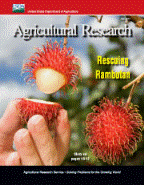United States Department of Agriculture: Agricultural Research Service, Lincoln, Nebraska

Agricultural Research Magazine
Date of this Version
2-2013
Document Type
Article
Citation
Agricultural Research February 2013.
Abstract
When strong winds carry away soil, microbes in the soil can act like hitchhikers and go along for the ride. With help from a wind tunnel and the latest DNA technology, Agricultural Research Service scientists are shedding light on the travel patterns of these soil-borne hitchhikers. The work has implications for soil health and could lead to management practices that minimize the damage to soils caused by wind erosion.
Scientists have been studying wind-eroded soils since the 1930s, but few studies have focused on wind’s effect on soil microbes. Microbes drive a number of critical processes, such as releasing enzymes that spur turnover of organic matter, sequestering carbon in the soil, and making nutrients available to plants.
Soil microbes include bacteria, fungi, and protozoa. Veronica Acosta-Martinez and Terrence Gardner in the ARS Wind Erosion and Water Conservation Unit in Lubbock, Texas, focused on bacterial populations that could be classified by DNA sequencing. Gardner is a visiting scientist in Acosta-Martinez’s laboratory, and his position is funded by Alabama A&M University.
The researchers characterized the bacterial diversity in eroded sediments and their soil sources, focusing on the types of bacteria associated with coarse particles and fine dust particles. They classified the bacteria found in each type of soil by phylum, class, and genus using pyro-sequencing, a process that allowed them to identify up to 100 times more DNA in each sample than what they would have detected with traditional soil-sequencing methods.
Included in
Agriculture Commons, Animal Sciences Commons, Food Science Commons, Plant Sciences Commons

